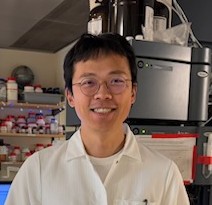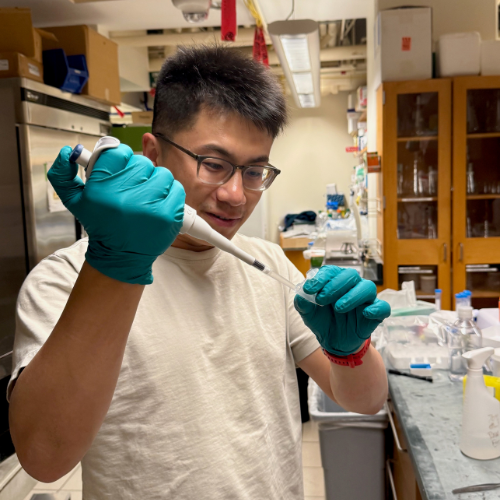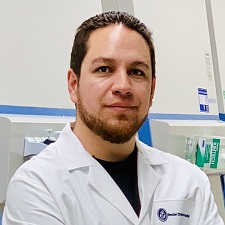Rachel Segal Greenberg, PhD

Interoceptive neural circuits are responsible for sensing internal changes in the body and initiating appropriate responses. In the context of female reproduction, these neurons sense internal states within the reproductive tract and maintain homeostasis by modulating functions like smooth muscle contractions, fluid flow, and communication with the central nervous system. The female reproductive tract undergoes major changes throughout life, ranging from pregnancy to gynecological cancers like high-grade ovarian carcinoma. Dr. Greenberg is investigating how interoceptive neurons monitor the female reproductive tract and modulate essential physiologies in these changing hormonal and biological states. Her research on the typical functions of reproductive neurons and on the neuronal contribution to tumor progression may suggest novel therapeutic approaches for gynecological cancer treatment.
Qinheng Zheng, PhD

There are two key types of cancerous mutations: one that turns on growth signals too strongly, like a car with a stuck accelerator, and the other that turns off safety mechanisms, like a car with broken brakes. While some cancers can be treated with drugs that block overactive growth signals—such as Gleevec for chronic myeloid leukemia—there are currently no effective treatments for cancers caused by the loss of these safety mechanisms, also known as tumor suppressor genes. Notably, mutations in TP53, one of the most common tumor suppressor genes, are abundant in almost all cancers, including breast, lung, and ovarian cancers. Dr. Zheng’s research focuses on reactivating these impaired tumor suppressor genes, such asTP53and FBXW7, to develop new treatment options for a wider range of cancers and to address resistance to existing therapies.
Fangyu Liu, PhD

Dr. Liu’s research focuses on discovering new drug candidates to treat pancreatic, colorectal, breast, and prostate cancers. Using advanced computational techniques to screen billions of chemical compounds, she aims to identify and develop highly specific molecules that target critical pathways in cancer cells while sparing healthy tissues. For example, she has uncovered compounds that modulate calcium-sensing receptors, which play a role in certain cancers, with reduced side effects compared to the current standard-of-care. She is now applying these insights to improve treatments that boost immune responses against tumors. Dr. Liu’s work not only strives to create new cancer therapies but also deepen our understanding of the complex interactions within tumors, paving the way for precision medicine tailored to individual patients.
Xin Gu, PhD

Dr. Gu’s [Sijbrandij Foundation Breakthrough Scientist] lab studies how cells regulate the destruction of proteins without using the typical "ubiquitin" tag, which signals that a protein should be transported to the proteasome for digestion and recycling of amino acids. The lab has discovered a new pathway, the midnolin-proteasome pathway, that helps degrade key proteins involved in cancer, including several linked to blood cancers like multiple myeloma. The lab’s goal is to understand this pathway better and explore how it might be used to develop new treatments, especially for blood cancers, by targeting specific proteins that drive disease.
Rongxin Fang, PhD

Cells must communicate with each other to maintain homeostasis and respond to external stimuli. This communication typically occurs through chemical signals or via direct physical contact. Dr. Fang plans to develop genomic tools to understand how different types of cells communicate with each other in the healthy brain and how communication goes awry in brain tumors. His goal is to determine whether and to what extent it is possible to manipulate specific genes or pathways underlying cell-cell communication to reverse disease progression in brain cancer patients.
Courtney Ellison, PhD

Courtney Ellison, PhD [Marilyn and Scott Urdang Breakthrough Scientist] is investigating how single bacterial cells join together to form complex, multicellular structures called biofilms. Biofilms protect bacterial cells from antibiotics and antimicrobial agents, making them difficult to eliminate. Some biofilm-forming species may cause certain cancers, and biofilms of infectious bacteria threaten immunocompromised patients such as those undergoing chemotherapy. Dr. Ellison focuses on bacterial appendages called type IV pili that play a crucial role in biofilm formation. Understanding the role of pili and their contribution to biofilm progression may lead to novel therapies to eliminate biofilms.
Junhong Choi, PhD

Dr. Choi develops a technology called “Molecular recording”, which allows the recording of cellular events and their lineage information into each cell’s genome. These innovative tools are critical for understanding the development of individual cells, both in normal developmental processes and in diseases like cancer. Recently, Dr. Choi has successfully demonstrated this technology by engineering human cancer cells to record their lineage or signaling events in a culture dish (“in vitro”) using CRISPR-based genome editing methods. Moving forward, Dr. Choi plans to further develop these methods to study cancer development. The goal is to uncover how specific characteristics of cancer cells emerge, ultimately identifying new targets for treatment.
Esteban A. Orellana Vinueza, PhD

Dr. Orellana Vinueza is investigating whether changes that modify the shape, stability and function of transfer RNAs (tRNAs) play a role in the development of cancer. The tRNA molecules are involved in the process that translates messenger RNA into a protein. Dr. Orellana Vinueza focuses on a tRNA methyltransferase complex that malfunctions in glioblastoma and liposarcoma. He will assess how alterations in the activity of this enzyme affect global patterns of methylation in normal and human cancer cells. Methylation is the process that controls the timing and amount of proteins that are produced in cells. Understanding how this process breaks down may help decipher the mechanisms that drive cancer and guide the development of new treatments.
